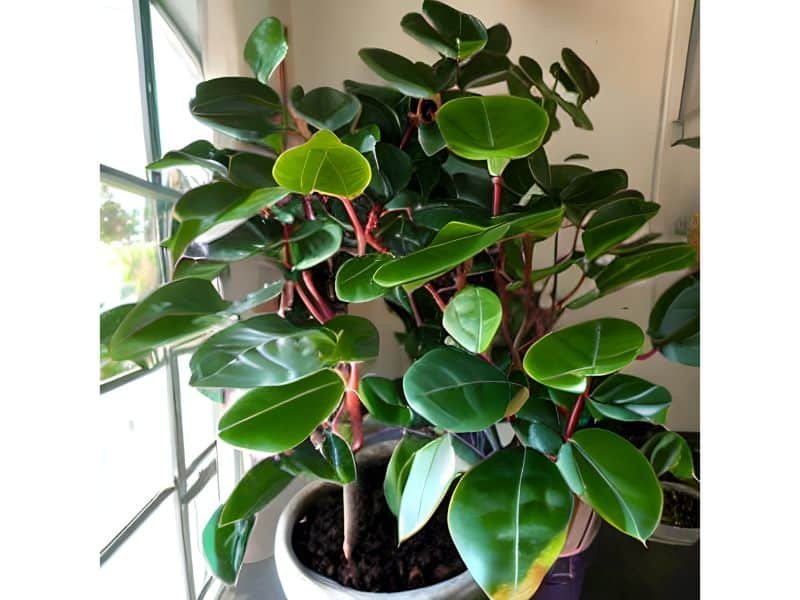Ficus robusta care for beginner doesn’t need to be complicated and time consuming even if you never have any experience caring for any plants before.
If you are new to growing Ficus robusta or are considering adding one to your indoor plant collection, this beginner’s guide of Ficus robusta care is for you. In this article, we will cover the key factors to consider when caring for Ficus robusta, including optimal growing conditions, proper care and maintenance, and troubleshooting common problems. With the right care, Ficus robusta can be a low-maintenance, attractive addition to your home or office.

Table of Contents
Optimal growing conditions for Ficus robusta
To ensure the best Ficus robusta care, it is important to provide the plant with the right growing conditions. Here are some key factors to consider:
Light requirements
Ficus robusta can tolerate a wide range of lighting conditions, from full sun to low, indirect light. However, it prefers bright, indirect light and should be protected from direct sunlight, which can cause the leaves to yellow and fade. If you are growing Ficus robusta in a room with limited natural light, consider placing it near a window that gets bright, indirect light.
Temperature and humidity
Ficus robusta prefers warm, humid conditions with temperatures between 60 and 75 degrees Fahrenheit. If the air in your home is dry, consider placing the plant on a humidity tray or misting it regularly to increase the humidity around the plant.

Soil type and watering
Ficus robusta prefers well-draining soil that is rich in organic matter. A good potting mix for Ficus robusta should contain a mixture of potting soil, perlite, and compost or peat moss. When watering Ficus robusta, be sure to water the plant only when the top inch of soil feels dry to the touch. The plant prefers evenly moist soil, but it is important to avoid over-watering, which can lead to root rot.
Caring for Ficus robusta
Proper care and maintenance is essential for Ficus robusta care. Here are some key factors to consider:
Fertilization
Ficus robusta should be fertilized once a month during the growing season with a balanced, water-soluble fertilize. Avoid over-fertilizing, as this can lead to leaf yellowing and other problems.
Pruning and grooming
Ficus robusta may benefit from occasional pruning to remove any damaged or diseased branches and to maintain a desirable shape. To prune the plant, use clean, sharp scissors or pruning shears and make cuts just above a leaf node. Avoid removing more than 25% of the plant’s foliage at one time.
Pest control

Ficus robusta is generally resistant to pests and diseases, but it can still be prone to problems such as spider mites and mealybugs. To control pests, you can try misting the plant with water, using a neem oil or insecticidal soap solution, or applying a systemic insecticide. Be sure to follow the instructions on the product carefully and take necessary precautions to protect yourself and the plant.
By following these Ficus robusta care and maintenance guidelines, you can help ensure that your Ficus robusta stays healthy and attractive.
Troubleshooting common problems
Even with the best Ficus robusta care, This plant can sometimes experience problems such as yellowing leaves, leaf drop, and pest infestations. Here are some tips for troubleshooting these common issues:
Yellowing leaves
Yellowing leaves can be a sign of over-watering, under-watering, or a nutrient deficiency. To fix this problem, check the soil moisture level and adjust your watering habits as needed. You may also want to fertilize the plant with a balanced, water-soluble fertilize to help correct any nutrient deficiencies.
Leaf drop
Leaf drop can be caused by a variety of factors, including sudden changes in light or temperature, inadequate watering, or a nutrient deficiency. To fix this problem, try to maintain consistent light and temperature conditions for the plant and make sure it is getting adequate water and fertilization.
Pest infestations
Ficus robusta is generally resistant to pests, but it can still be prone to issues such as spider mites and mealybugs. If you notice signs of a pest infestation, such as yellowing leaves or small insects on the plant, try using a neem oil or insecticidal soap solution to control the pests. You can also try applying a systemic insecticide or using physical methods such as removing the pests by hand.
By identifying the cause of any problems with your Ficus robusta and taking appropriate action, you can help keep the plant healthy and thriving. If you are unable to solve the problem or if the plant shows signs of severe distress, consider seeking the advice of a horticulturalist or plant specialist.
Conclusion
In conclusion, Ficus robusta is a beautiful, low-maintenance plant that can thrive in a wide range of lighting conditions and bring a touch of greenery to any room. By providing the plant with optimal growing conditions, including bright, indirect light, warm, humid temperatures, and well-draining soil, and by following proper care and maintenance guidelines, you can help ensure that your Ficus robusta stays healthy and attractive.
you encounter any problems with the plant, such as yellowing leaves, leaf drop, or pest infestations, try to identify the cause of the issue and take appropriate action to resolve it. With the right care, Ficus robusta can be a long-lasting and rewarding addition to your indoor plant collection.

Gardening is my passion and growing plants indoors has always been a stress relief for me. Grow a banana tree in my apartment once (although failed to produce bananas).






